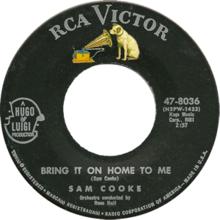Bring It On Home To Me
| "Bring It on Home to Me" | ||||
|---|---|---|---|---|
 |
||||
| Single by Sam Cooke | ||||
| A-side | "Having a Party" | |||
| Released | May 8, 1962 | |||
| Format | 7" | |||
| Recorded | April 26, 1962 RCA Studio 1 (Hollywood, California) |
|||
| Genre | Rhythm and blues, soul | |||
| Length | 2:37 | |||
| Label | RCA Victor | |||
| Writer(s) | Sam Cooke | |||
| Producer(s) | Hugo & Luigi | |||
| Sam Cooke singles chronology | ||||
|
||||
| "Bring It On Home to Me" | ||||
|---|---|---|---|---|
 |
||||
| Single by The Animals | ||||
| from the album Animal Tracks (U.S. album) | ||||
| B-side | "For Miss Caulker" | |||
| Released | March 1965 | |||
| Format | 7" single | |||
| Recorded | March 1965 | |||
| Genre | Rock, blues, pop, soul | |||
| Length | 2:43 | |||
| Label | Columbia | |||
| Writer(s) | Sam Cooke | |||
| Producer(s) | Mickie Most | |||
| The Animals singles chronology | ||||
|
||||
| "Bring It on Home to Me" | ||||
|---|---|---|---|---|
| Single by Mickey Gilley | ||||
| B-side | "How's My Ex Treating You" | |||
| Released | June 1976 | |||
| Format | 7" | |||
| Recorded | May 1976 | |||
| Genre | Country | |||
| Length | 2:23 | |||
| Label | Playboy 6075 | |||
| Writer(s) | Sam Cooke | |||
| Producer(s) | Eddie Kilroy | |||
| Mickey Gilley singles chronology | ||||
|
||||
"Bring It on Home to Me" is a song by American soul singer Sam Cooke, released on May 8, 1962 by RCA Victor. Produced by Hugo & Luigi and arranged and conducted by René Hall, the song was the B-side to "Having a Party". The song peaked at number two on Billboard's Hot R&B Sides chart, and also charted at number 13 on the Billboard Hot 100.
The song has become a pop standard, covered by numerous artists of different genres. It is one of The Rock and Roll Hall of Fame's 500 Songs that Shaped Rock and Roll.
"Bring It on Home to Me", like its A-side, "Having a Party", was written while Cooke was on tour for Henry Wynn. The song was initially offered to fellow singer Dee Clark, who turned it down. While in Atlanta, Cooke called co-producer Luigi Creatore and pitched both numbers; he was sold and booked an immediate recording session in Los Angeles scheduled for two weeks later. The session's mood "matched the title" of the song, according to biographer Peter Guralnick, as many friends had been invited. "It was a very happy session," recalled engineer Al Schmitt. "Everybody was just having a ball. We were getting people out there [on the floor], and some of the outtakes were hilarious, there was so much ad lib that went on."René Hall assembled an eighteen-piece backing group, "composed of six violins, two violas, two cellos, and a sax, plus a seven-piece rhythm section that included two percussionists, two bassists, two guitars, and a piano."
...
Wikipedia
